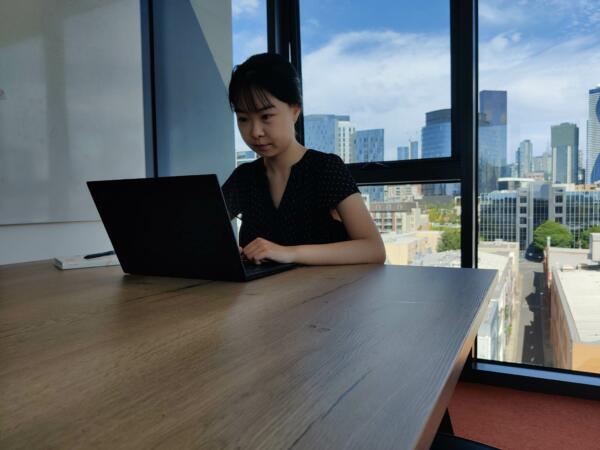It is Saturday morning, and I am leaving my apartment to go to university.
As I walk out, the corridor is full of people standing in a parallel line that extends about six metres – all the way to the lifts.
There are about 45 people, each waiting to inspect an apartment that has recently been put on the rental market.
I wonder: why is there such a high turnout to inspect one apartment, when so many are empty across Victoria?
Let’s break it down.
What are unoccupied dwellings and why are there so many of them?
[T]he Australian Bureau of Statistics (ABS) defines unoccupied dwellings as residences, such as houses and apartments, with no one living in them on the night a census is conducted.
The most recent census data shows the number of unoccupied apartments in Victoria has nearly doubled since 2016.
Demographer Glenn Capuano says there are a few reasons why the number of unoccupied dwellings was high in 2021, with many related to the COVID-19 pandemic.
Higher-density dwellings are concentrated in the inner city, Capuano, says. During the pandemic, more of these dwellings were unoccupied due to the numbers of overseas students – who live in the inner city to be close to jobs and tertiary institutions – who went home.
Pandemic lockdowns also saw more people temporarily move from Melbourne to regional Victoria, where many could work remotely with fewer restrictions, says the lead demographer at .id consultancy.
But a close look at the data suggests the pandemic is not the only explanation for the low occupancy rate of residential units.
In 2019, land tax advocacy group Prosper Australia reported that 16 per cent of investment properties in Melbourne were unoccupied, based on an analysis of household water usage across Melbourne. The report concluded that more than 65,000 dwellings were empty in 2019 alone.
Is the explanation for the rise in empty nests related to whether a dwelling was bought as a primary residence or an investment?
While the ABS does not have a specific classification for residential dwellings that are investment properties, the Reserve Bank of Australia (RBA) says that household tenure type can be a good proxy for assessing the proportion of housing stock owned by investors versus owner occupiers.
Analysing relevant census data, it appears investors are the landlords with the highest unoccupancy rate (the “not applicable” category in the final column in the graph above). According to RBA analysis, these properties would likely include investment properties available for rent but currently untenanted and investments deliberately left vacant (as well as those bought for partial owner-occupation, such as secondary or holiday-homes).
This is despite incentives for investors to keep their properties occupied. In Victoria, residential properties in 16 local government areas that are unoccupied for more than six months per year are subject to a vacant residential land tax of one percent of the property’s value.
This means that an investor will have to pay $4,500 for an apartment worth $450,000 that remains unoccupied for more than half the year.
What impact do unoccupied dwellings have on prospective tenants?
[H]engying Wu is a recent university graduate who will have to move out of her student accommodation unit as her contract expires in a few days.

She has spent the past month going to inspections and lodging applications for rental units, but is one of many tenants struggling to secure an apartment due to the tight rental market.
“It is so difficult,” she says.
Attending multiple inspections has made Wu realise that she is not only competing with applicants located in Melbourne.
“I met another student who’s applying for an apartment for her friend who is currently back in China,” she says.
Having a limited amount of time to find a place to live in while potentially competing with the more than 40 applicants attending each inspection, and further international applications, is adding to Wu’s desperation in her search for housing.

“I just feel this is impossible,” she says.
Increased competition for rental units is also pushing some applicants to offer landlords payments that exceed the listed rent price, an illegal practice known as rent bidding.
“For example, if it’s $480 per week, they would raise it to $500 or even more to secure the apartment for themselves and they would pay, like, six months’ rent in advance,” she says.
Wu says if she does not manage to find a new place to live in before she has to vacate her student accommodation, she will have no other option than to move into a short-term rental or Airbnb.
Advocates call on the government for reform
[P]eople desperate to find a place to call home will often accept poor living environments as a last resort, says director of community management at peak body Tenants Victoria, Farah Farouque.
“We see students moving into unregistered rooming houses where people are sharing bedrooms with strangers – just to get a basic bed and with very uncertain, precarious conditions,” she says.
According to Farouque, the increasing rates of unoccupied private dwellings, low vacancy rates and rising costs are all exacerbating the rental crisis in Victoria.
“We’ve seen some people’s rent increase from [an extra] $30 a week to hundreds of dollars – so that actually means that some people can’t afford to remain in the existing rental properties, but then the competition is so huge, so they’re sort of between the devil and the deep blue sea,” she says.
While more apartments have been built in the past five years, the number of unoccupied dwellings has simultaneously increased.
Meanwhile, recent CoreLogic data shows that since the 2021 census, the median rent in Melbourne has increased to $551 per week. The median for apartments and units was $528 per week, up 10 per cent in the past 12 months.
Sharply rising rents are clearly an affordability issue for tenants like Wu. But they also appear to indicate that strong rental returns do not appear to be enough of an incentive for residential property owners to ensure their dwellings are occupied.
What can be done? While the Victorian government has pledged $5.3 billion for a Big Housing Build to boost social housing and the construction of affordable dwellings, it has not announced further measures to tackle the sleeping issue of apartments that remain empty.
Farouque says all levels of government should collaborate to come up with solutions.
“It’s a market situation and we have no means to compel these investors to [list empty dwellings],” she says.
“We’re in the middle of a rental crisis, all properties that are rentable should be made available.”





















